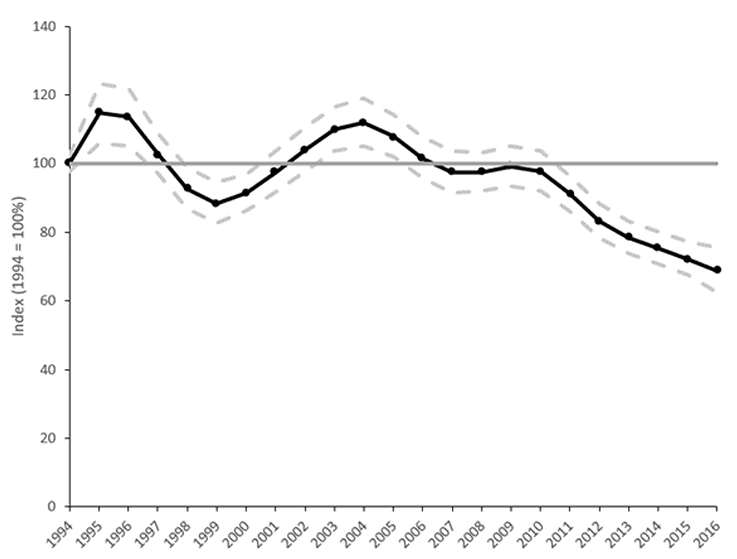Biodiversity strategy: consultation
Biodiversity is vital for us all and it is in crisis, globally and in Scotland, so we need to change the way we use natural resources. We are seeking views on how we should tackle the biodiversity crisis through a new biodiversity strategy which will drive this transformation.
2. The Evidence of Biodiversity Loss
The evidence of biodiversity loss, both nationally and globally, continues to mount. In Scotland, sources of evidence include Scotland's Biodiversity Strategy Indicators; the 2019 State of Nature report; the Biodiversity Intactness Indicator; Scotland's Marine Assessment 2020; the 6-yearly assessment of progress towards Good Environmental Status under the UK Marine Strategy (which was last updated in 2019); and periodic assessments undertaken by The Convention for the Protection of the Marine Environment of the North-East Atlantic (the 'OSPAR Convention').
Internationally, the UN's Global Biodiversity Outlook (September 2020) and the IPBES Global Assessment of Biodiversity (May 2019) describe the pressures on nature. The latter identified five direct drivers of global biodiversity loss:
- Changing use of the land and sea especially for agriculture, forestry, fish farming and coastal infrastructure;
- Direct exploitation of organisms via harvesting, logging, hunting and fishing;
- Climate change;
- Pollution; and
- Invasive non-native species.
These emerge from a range of indirect drivers of biodiversity loss, including socio-cultural values and behaviours, demographic and consumption factors, poor governance and the impacts of some technological innovations.
In Scotland, almost all of the land surface has been altered by us, resulting in one of the lowest biodiversity intactness indexes in the world undermining our ability to rely on our natural environment to hold onto its carbon stocks and sequester greenhouse gas emissions. It is increasingly recognised that the climate and biodiversity crises are intrinsically linked and need to be tackled together.
17.6% of Scotland is protected specifically for nature either as SSSIs[1], SACs[2], SPAs[3] or Ramsar[4] sites. 37% of our seas now form part of the Scottish MPA network.
In Scotland, the evidence on biodiversity decline is strong and demonstrates that Scotland is seeing dramatic declines in its biodiversity:
- There has been a 24% decline in average abundance of 352 terrestrial and freshwater species since 1994 – noting that 1994 was not, itself, a high point;
- There has been a 14% decline in range for 2,970 terrestrial and freshwater species since 1970;
- Peatlands are in such poor condition that they are emitting, instead of storing, carbon and are responsible for 20% of Scotland's total emissions;
- Only around 64% of Scotland's protected woodlands are in a favourable or recovering condition;
- Out of 15 components in the UK Marine Strategy, 11 of them had not achieved Good Environmental Status by 2020, with recognition that more action is required;
- Scotland's Marine Assessment 2020 highlighted declines in biogenic habitats and species such as Atlantic salmon; that fishing remains a widespread impact on the seabed; and that climate change is now the most critical factor affecting the marine environment;
- There has been a 38% decline in the Scottish breeding seabird indicator between 1986 and 2016. Abundance indicators for fish species show some signs of recovery from deep historic lows;
- Our new terrestrial and marine species indicator gives a robust image (below) of decline[5];
- Only 30,000 hectares of Scotland's unique Atlantic rainforest remains and is highly fragmented;
- Indicators show an increasing spread of 190 established invasive non-native species (INNS) across terrestrial, freshwater and marine environments in GB during the last six decades – with a northwards shift a common pattern.

Globally, when they are functioning well, ocean and land ecosystems remove around 50% of human-made CO2 emissions each year: our failure to protect our natural resources is reducing our ability to tackle climate change. The more global warming exceeds 1.5°C, the more likely we are to experience major impacts on ecosystems, triggering feedback loops that will accelerate warming.
Children's contact with the natural world is in decline and according to recent research from the RSPB, four out of five UK children are not connected to nature.
A 2017 RSPB Birdwatch survey, assessing nature knowledge in parents rather than children, found that of 2,000 adults, half couldn't identify a house sparrow, a quarter didn't know a blue tit or a starling, and a fifth thought a red kite wasn't a bird – but nine out of 10 said they wanted children to learn about common British wildlife.
Question:
Using your own knowledge and the evidence presented, to what extent do you agree that there is a nature crisis in Scotland? Why do you think that?
Question:
What do you see as the key challenges and opportunities of tackling both the climate and biodiversity crises at the same time?
Contact
Email: biodiversity@gov.scot
There is a problem
Thanks for your feedback